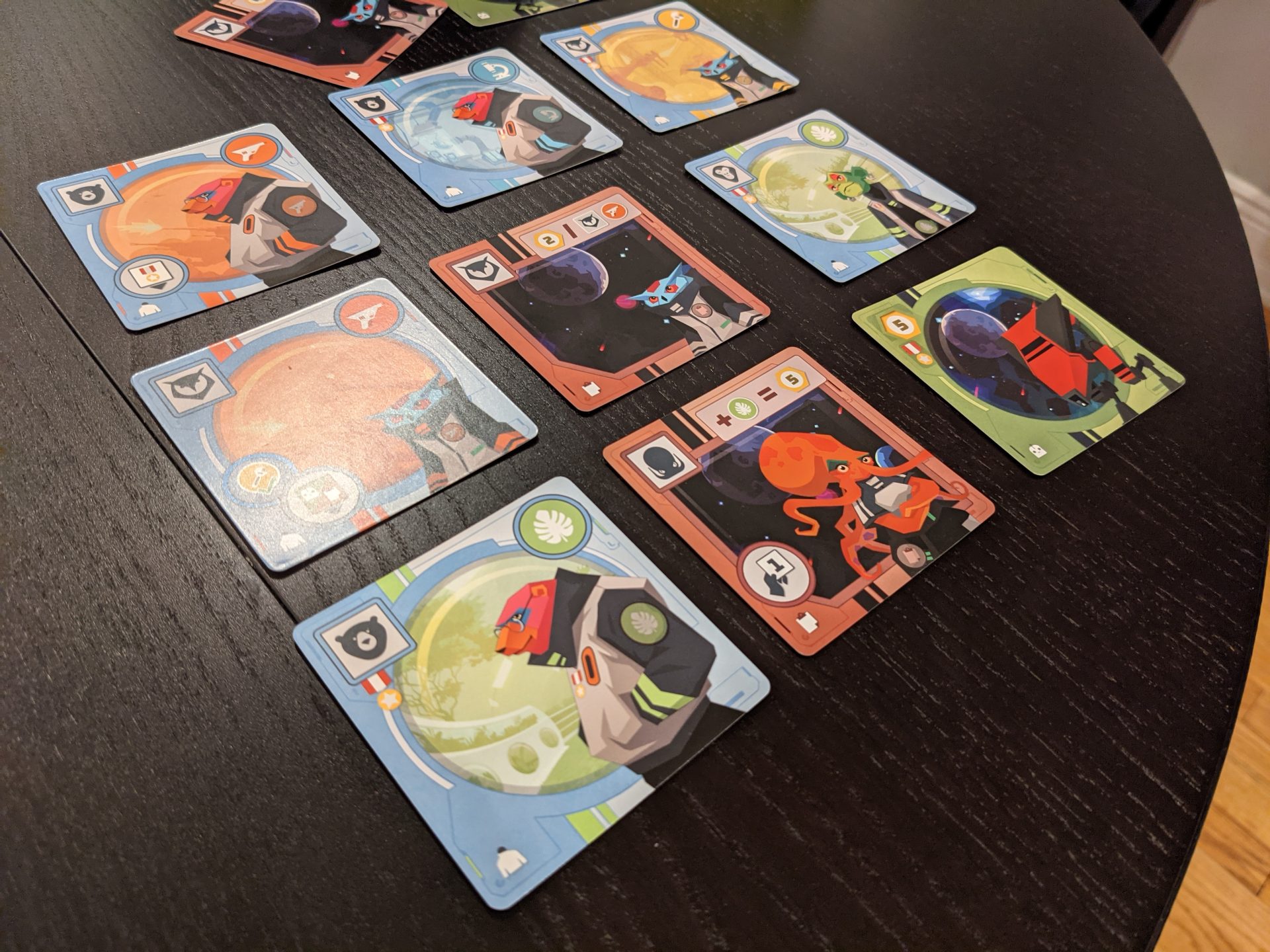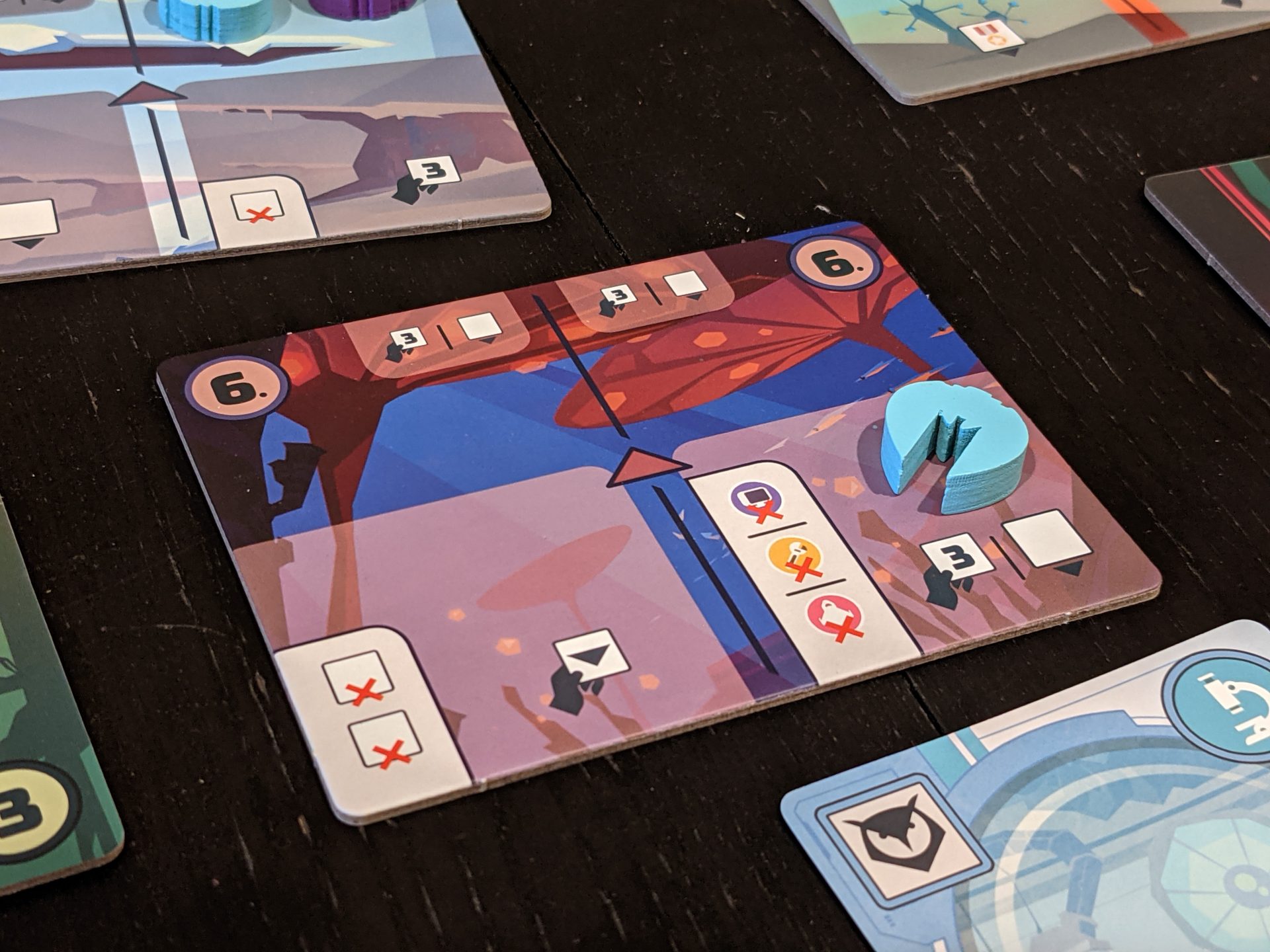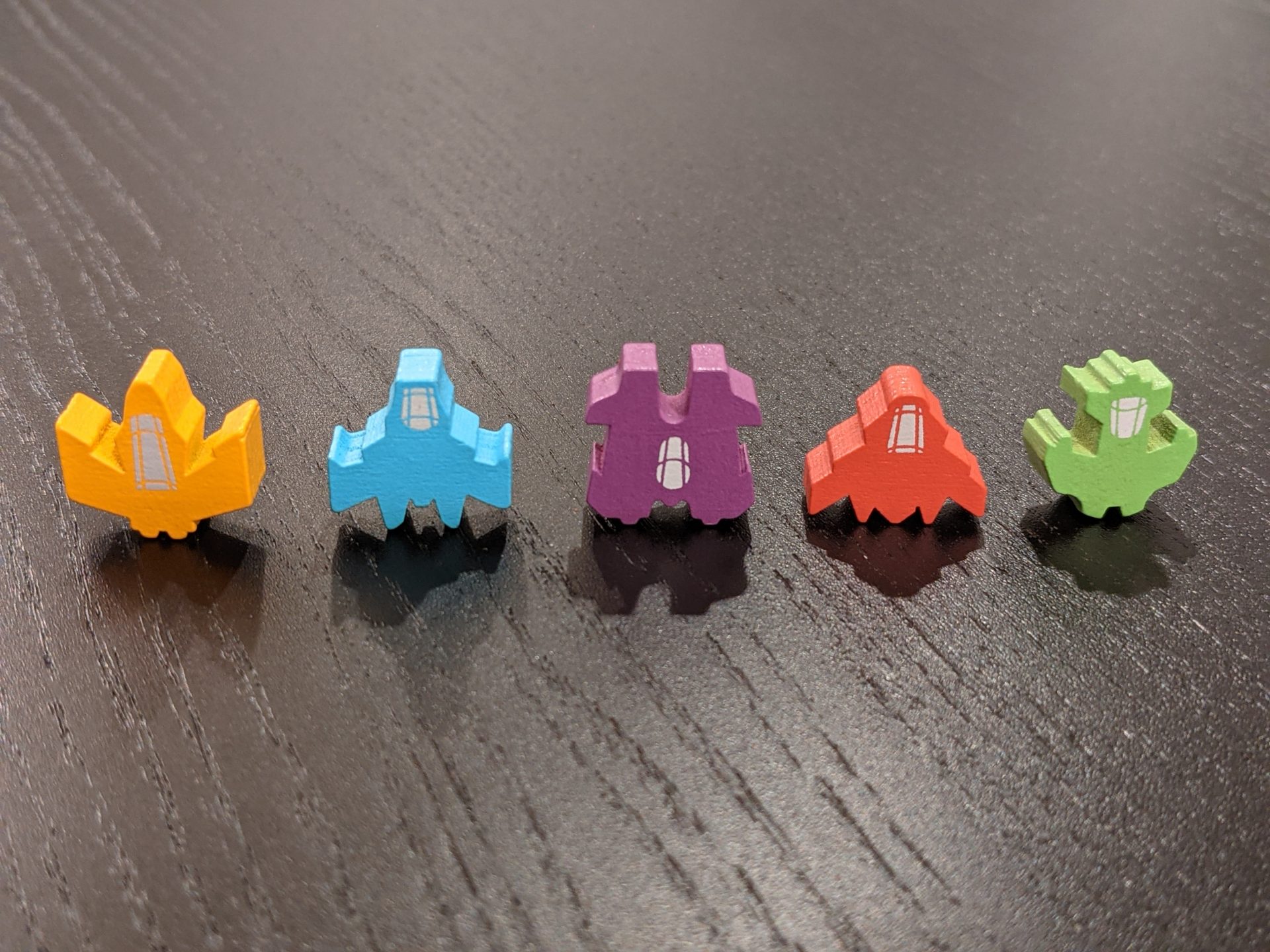Disclosure: Meeple Mountain received a free copy of this product in exchange for an honest, unbiased review. This review is not intended to be an endorsement.
I truly believe that gamers of all stripes need to have a few “filler” games in their collection. When I say filler, I mean a game that you can put in front of any audience and find engaging decisions to make, all in under 30 minutes of playing time. Something easy to set up, teach, and pack up in time for the main course of your regular gaming extravaganza.
Wild Space is one of those games. I’ve played it a bunch in the 8 days I have had it, and I’ve been impressed with it every time. From the moment you look at the box cover, to the first time you pull off a wild five-card combo, Wild Space will get its hooks into you. It’s a lot of fun and fit for the whole family.
But let’s slow down for a moment. What makes Wild Space…wild?

Octopii, Lizards, Bison…Oh My!
Wild Space will probably be cast as an engine builder when it gets to the masses this September, but I don’t think that’s the proper angle here.
Over the course of 10 rounds, Wild Space pushes you to build a great hand to string card combos together, building towards a magnificent scoring tableau of set collection. While the backstory seems to hint at exploring new galaxies in search of treasure, my plays of Wild Space have come down to one thing: building a hand of cards which can be played most efficiently by the end of the game.
Your goal is to score the most points over those 10 turns. At the start of the game, each player is dealt a captain, falling into one of six species and one of six occupations. Then, with a starting hand of 3 cards, you’ll place one of your 5 spaceships on one of the 5 Planet available tiles to take actions. Each Planet is split into two sectors, and a player can never have more than one of their own ships in each sector. After placing a ship at the bottom of the selected sector’s Landing Zone, you’ll take the specific action there; at a point later in the game, you’ll take a second action with that ship in the upper portion of that sector to explore it, by drawing three cards into your hand or playing one into your tableau.
The Landing Zone actions are the only ones you really need to teach, and the iconography is so good in Wild Space that my 7-year-old picked up on it by her second playthrough. (I don’t think she grasped all the best strategies in her 2 plays, but she was fully capable of taking actions.)
These actions range from playing specific occupation cards from your hand, to conditional actions such as having to discard a card before playing a different one, or having played certain types of crew cards into your tableau first. Each Planet’s sectors are gated by the number of cards you have already played; to begin the game, you only have the choice of 4 sectors on the 2 opening planets. But as your crew (i.e. tableau) grows, players can flip additional planets which have increasingly better actions, assuming you can meet the conditional requirements of those spaces.
All of this is pretty standard stuff; where Wild Space offers something special is in the one-time bonus actions that appear on most crew cards, known as Ability Circles. These allow for a player to take an additional action immediately, assuming they meet any requirements on that card.
The Ability Circles are the reason why I keep coming back to Wild Space. I usually play a game 3-5 times before writing a review, but I have already played Wild Space 7 times and I still haven’t played it at a full 5-player count. The best way to build chains is to collect a range of cards that fit the Ability Circle requirements on other cards. Pulling off a mutli-card combo turn just feels good, and in a short game like Wild Space, it allows for everyone to have an epic moment or two before you get to final scoring.
About those cards: there are 108 crew cards in the deck, broken into 3 categories:
- Specialists, which generally make up the majority of the cards, you’ll play into your tableau. All the Specialists are animals from 1 of 6 species: owls, lizards, bears, octopii, bison, and monkeys. This is important for end-game scoring purposes, in addition to fulfilling some of the missions of the Emissary cards.
- Emissaries, which are basically mission cards that can generate end-game points if you have the most of a certain occupation, or fulfill other set collection objectives.
- Robots, which usually grant straight-up points at the end of the game, but sometimes grant other one-time effects.
All Specialists and most Robots show 1 of 6 occupations such as pilots, programmers or scientists. Some of those Specialists and Robots are also listed as Veterans, with a little medallion icon in the upper left-hand corner. Playing Veterans usually stop your Ability Circle combos, but that’s where your captain’s Veteran tracker comes into play.
On the top of each captain card is a tracker that shows a bonus for each Veteran you play. Sometimes, you get to draw cards. Sometimes, you’ll get to play an additional card, which has led to some incredible moments in my games: someone will play a 3-card combo, ending with a Veteran, which triggers a move on that player’s Veteran tracker that allows them to play another card, which leads to another 2- or 3-card combo.
YESSSSSSSSSSSSSSSS!
End-game scoring is easy. You’ll score points for sets of at least 3 cards of any species in your tableau, with a big bonus if you somehow play at least one card from all six species. Then you’ll get additional points for points on your captain’s Veteran tracker, Robots, and Emissary missions you have completed.
One additional note about the rulebook: it’s excellent. Great intro upfront about the different types of cards in the game, rules are very clearly defined, and the back cover has all the icons detailed for players to sort out what their cards mean. Wild Space has the best rules overview I have seen in a new game this year.

Oh, Those Animals!
Look at that cover photo at the top of this review; Wild Space has a very slick look. The art by Amélie Guinet is simple, but it really hooked me with its bright, bold colors and straightforward impressions of, say, a bear in a space uniform.
My daughter, in particular, really loves the artwork of Wild Space. I found that sometimes, she was trying to get monkeys or bears because she liked those illustrations; this doesn’t hurt because you can score a ton of points in this way at the end of a game.
Sadly, the instruction booklet doesn’t detail the six species (I am just making guesses based on what my eyes tell me, but maybe “lizard” doesn’t quite cut it!) or why we have these six species in the game. Further, there’s no backstory on the captains, or why everyone seems to be wearing roughly the same uniforms in different colors—despite the fact that these crewmembers are all working for different captains on different spaceships. We just get cool-looking animals with clean icons and illustrations. This feels like a missed opportunity to tell even a token amount of story. Maybe this is why I haven’t been caught up in the theme and instead just focus on building the best hand.
The Planet tiles look good, even though there are a limited number of them. (You will only see 3 of the 8 non-home Planet tiles in any one game.) And while the spaceships—essentially, your workers—included in the core box worked just fine for me, I will admit that the screen-printed promo ships Pandasaurus included in our review copy are a nice upgrade. Basically, these promo ships are in five distinct shapes and have a cockpit printed on one side of each piece. Nice touch!

Kick Off the Night By Going to Space!
While I typically donate review copies and prototypes to board game cafes, charity auctions or the friends that help me review products, I’m holding onto my copy of Wild Space.
Wild Space t plays so well, so quickly, and for such a wide range of audiences, that I don’t see it leaving my collection any time soon. I’ve played this with my daughter, my wife, even my mom (!!), and all of them enjoyed their plays.
Wild Space is not a terribly deep experience. I’m already beginning to seek out certain Emissary cards because I can see how they help drive a strategy for diversity while maximizing scoring opportunities no matter which cards I play. The Planets, as mentioned, are not very diverse, even if they are very pretty. And while the solo play helps new players, I easily beat this mode in easy and intermediate, with the difficult/expert level beating me by a single point the one time I gave that a spin. You’ll do solo a few times mainly to prepare to teach the game to new players.
But otherwise, Wild Space really understands its place in the world: a simple, fantastic and beautiful addition to the hobby. Pandasaurus has had one hell of a year: Umbra Via, The Loop, Trek 12, Brew, and the upcoming Machi Koro 2. I’m excited to try all of these products and more very soon!












Add Comment